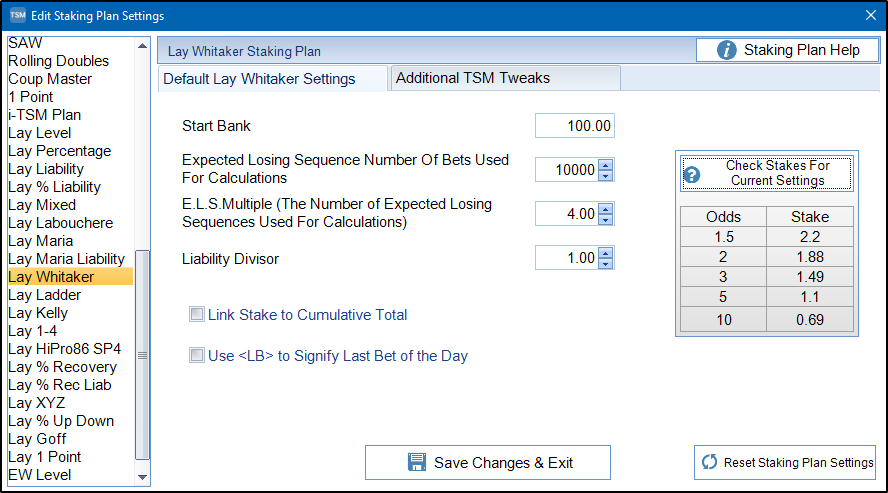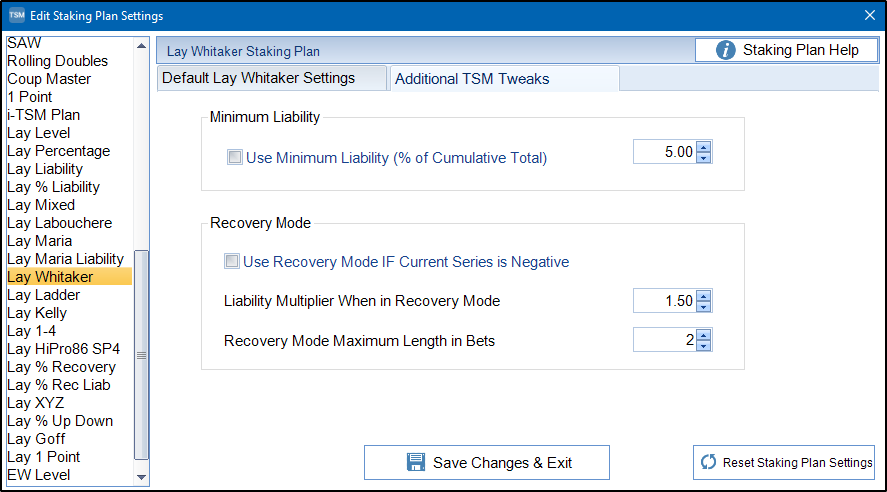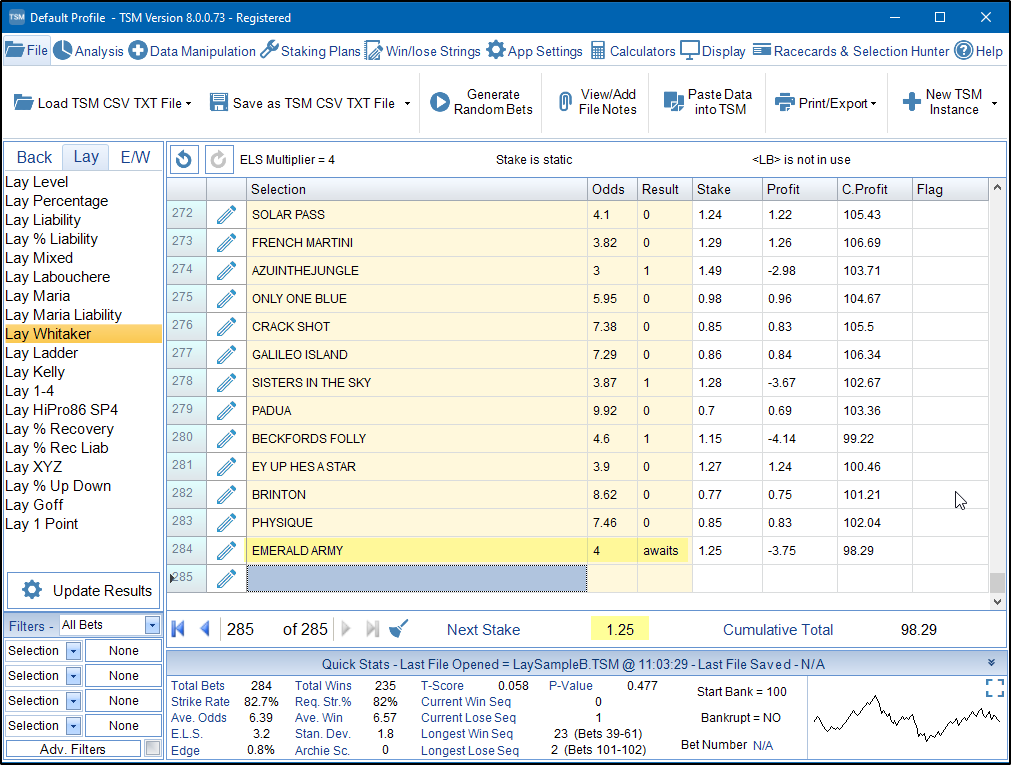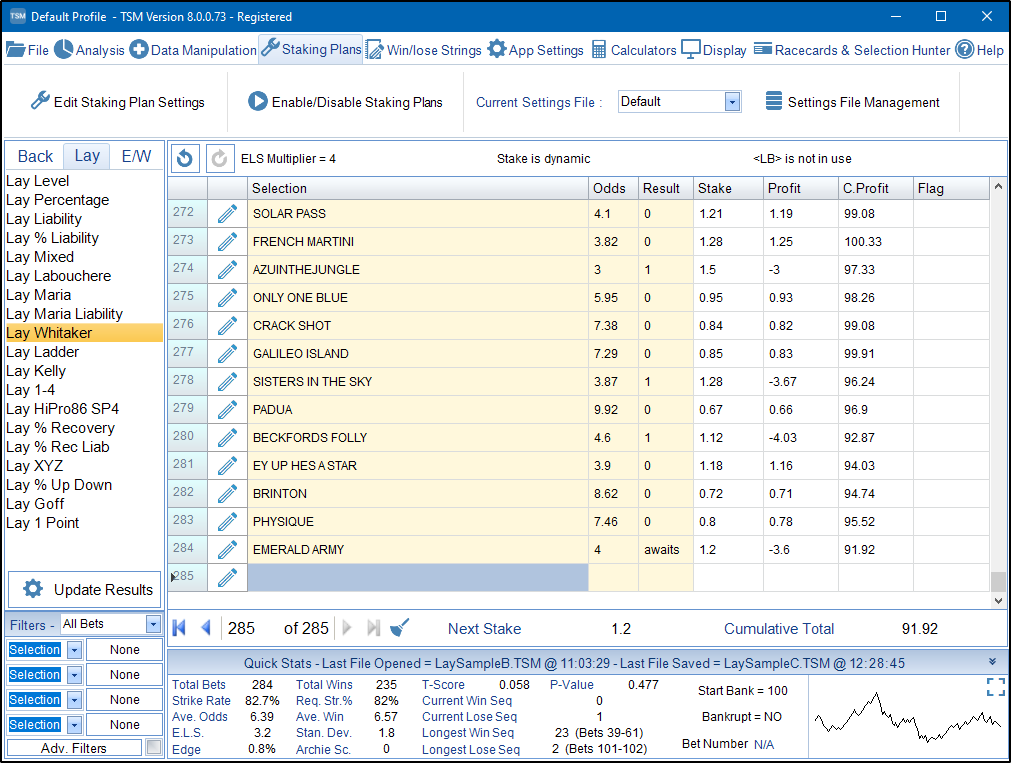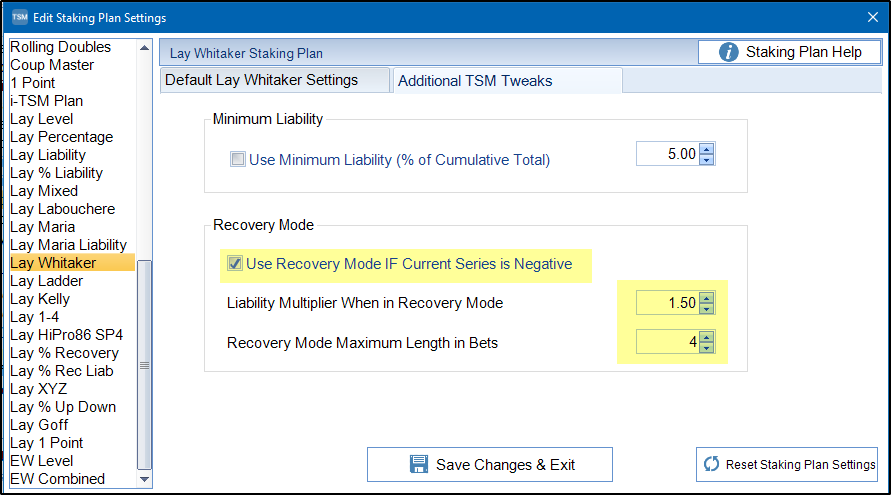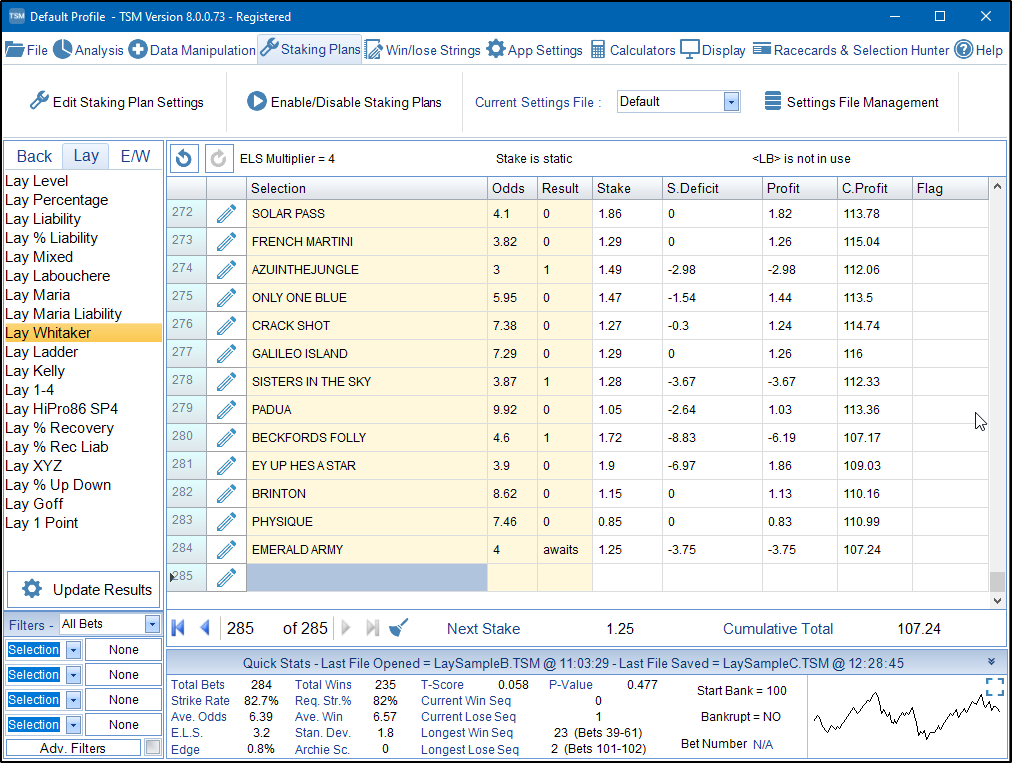Lay Whitaker Staking Plan
The Lay Whitaker Staking Plan. This is the Lay Version of the Back Whitaker Staking Plan.
Lay Whitaker Staking Plan
With Lay Whitaker, the liability for each bet is directly linked to the odds of each bet. It does this by converting the bet odds into the implied Strike Rate and then calculating the Expected Losing Sequence (E.L.S.) for that Strike Rate. It then gives the E.L.S. a multiple so that our start bank can deal with multiple losing runs of the E.L.S. figure. Usually, the multiple is anywhere from 4 to 10. The Start Bank is then divided by this number (E.L.S. x Multiple) in order to determine the liability and stake.
The Calculations
Betting Bank
E.L.S. of Implied Lay Strike Rate x E.L.S. Multiplier
= Liability Points
Where Implied Lay Strike Rate = 1 – (1 / Back Odds)
Stake = Liability Points * Implied Back Odds Strike Rate
Where Implied Back Odds = (1 / Lay Strike Rate)
- Betting Bank: Initially this is the start bank – let’s call this £100.
- Implied Strike Rate: Let’s assume our bet odds are 4. The implied strike rate is simply 1 divided by the bet odds. So, in our example, 1 divided by 4. This makes our implied strike rate = 0.25 or 25%. In order to convert this to the implied lay strike we simply subtract from 1. The Implied Lay Strike Rate is therefore 1 – 0.25 = 0.75 or 75%.
- E.L.S. of Implied Strike Rate: The E.LS. is calculated using some clever maths. TSM users will be familiar with the E.L.S. as we have had access to a built in E.L.S. Calculator for many years. When we calculate the E.L.S. we have to decide how large our sample set should be. In this example we use a sample of size of 10,000 bets. Plug this in to the E.L.S. Calculator and the E.L.S. is 6.64 for a strike rate of 75%. Read more on E.L.S. in TSM.
- E.L.S. Multiplier: This is used to protect the bank. A number from 4 – 10 is often used. If we use 4, then this means we can expect our betting bank to withstand 4 losing sequences of 6.64 bets in a row before going bankrupt. In this example we will use 4.
100
6.64 x 4
= 3.76
In order to calculate the stake, we calculate the implied back odds of our lay strike rate. This is simply 1 / 0.75 = 1.33
We then calculate our final stake by multiplying the implied back odds -1 by the Liability Points
3.76 * (1.33-1) = £1.25
The stake we would use with the settings described and the bet odds of 4 would be £1.25
TSM Settings
As you would expect all the settings mentioned above can be edited in TSM. On the Default Lay Whitaker Settings tab there is another option called Liability Divisor. This simply divides the calculated stake/liability further – keep it at one (1) if you don’t want additional reduction.
There is also the option to Link the Calculated Stake to the Cumulative Total. Instead of a using the fixed start bank throughout, we can use the cumulative total itself. This means that as the cumulative total increases, as will the stakes.
My preferred betting method is to re‑adjust stakes after every betting day. That way, you can place multiple bets simultaneously (e.g., football bets), knowing the calculated stakes will be accurate.
We can tell TSM that it is the end of the betting day by adding the code <LB> to the selection text. TSM will then use the current cumulative total for next series of bets.
Additional TSM Tweaks
One of the principles of this staking plan is that each bet placed has its own probability of winning. However, in an ideal world every bet placed in our selection system would have the same probability of winning. To counter that, TSM has added a Minimum Stake/Liability option that is set as a percentage of the cumulative total.
We have also added a Loss Recovery Option into the staking plan. Similar to Bookies Bank in that as soon as your current betting series is negative, Recovery Mode is entered. A Stake/Liability Multiplier is then used on the next stakes until such as point the series is positive or the Recovery Mode Bet Limit is reached. This can be as aggressive or passive as per your own risk threshold.
Screenshots
The example above uses the settings we used earlier in our example. Bet 284 actually has odds of 4 and you see the calculated stake is £1.25.
Note: In TSM in order to calculate the next stake for staking plans that require the bet odds we use the ‘awaits result’ string. At default this is simply the string ‘awaits’. Bet 284 has an awaits result string and a calculated next stake of £1.25.
In the example below I have linked the cumulative total to the stake. We can see the cumulative total has decreased further as the stake adjusted over time. Ideally we would like to see the cumulative total increase but I have used this example to show that the stake will increase/decrease realtive to the cumulative total. The next stake is also reduced to £1.2
In the final example we are using the Loss Recovery Mode with Recovery Stake Multiple of 1.5 and a recovery bet limit of 4. Link to Cumulative Total is OFF.
We can see the cumulative total has increased from £98.29 to £107.24.
Although the Minimum Stake and the Recovery Option in TSM for the Lay Whitaker Staking Plan is not officially part of the Lay Whitaker Staking Plan we hope you will find them useful in your betting.

